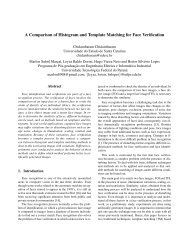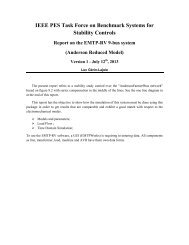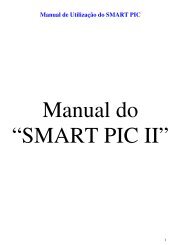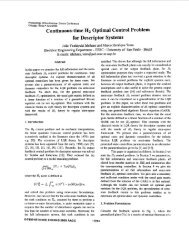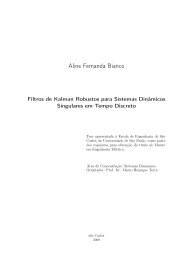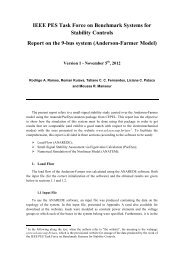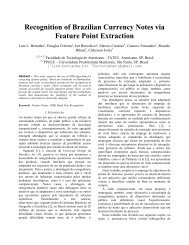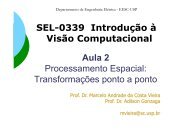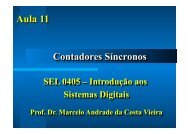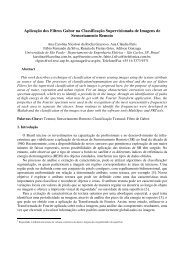III WVC 2007 - Iris.sel.eesc.sc.usp.br - USP
III WVC 2007 - Iris.sel.eesc.sc.usp.br - USP
III WVC 2007 - Iris.sel.eesc.sc.usp.br - USP
Create successful ePaper yourself
Turn your PDF publications into a flip-book with our unique Google optimized e-Paper software.
<strong>WVC</strong>'<strong>2007</strong> - <strong>III</strong> Workshop de Visão Computacional, 22 a 24 de Outu<strong>br</strong>o de <strong>2007</strong>, São José do Rio Preto, SP.Real images of some of the simulated cases were alsoobtained, whose results are shown in Figure 5, for the setof 5 point sources and the annular source. Notice theresemblance with the simulated results.Figure 5. Images obtained with a Siemens-Orbitergamma-camera, the coded mask-based multipinholecollimator previously presented and a RL-based decodingalgorithm (15 iterations) of (a) a set of five point-likesources in a “+” pattern, 5 mm away one from the otherand (c) an annular source 20 mm in diameter and 2 mmwidth. In (b) and (d), cuts along the central line of eachimage are presented. Most of the width of thereconstructions is caused by the finite size of the sources.4. ConclusionsIn this work we have presented details of theimplementation of a high spatial and temporal resolution<strong>sc</strong>intigraphic imaging system, based on the coded maskmultipinhole technique, in combination with aconventional clinical gamma-camera and an appropriatedecoding algorithm. Even though coded mask collimatorshave been successfully used for decades in the field ofhigh energy astrophysics, this kind of collimators has notbeen extensively used in near field, in spite of its abilityto produce, simultaneously, high spatial and temporalresolution. Nevertheless, multipinhole collimators,consisting of a smaller number of holes, have been usedto produce images of small FOVs, in combination withiterative restoration image algorithms based on theMaximum Likelihood RL algorithm (e.g., [1, 2]).Simulations and experimental results indicate thatcoded masks can be used to improve the spatial andtemporal resolution of gamma-ray imaging of smalltargets in the near field by increasing the total open areaof the camera, while maintaining the equivalent highspatial resolution of a small size pinhole camera and, inthis way, allowing for dynamical studies of radiotracers.When in the far field application, images obtained withthe use of appropriately <strong>sel</strong>ected coded mask collimators(namely, URAs) are perfectly decoded by the cros<strong>sc</strong>orrelationof the shadowgram with an appropriatedecoding array. In the near field applications presentedhere, where the objects were always inside the FOV, theimages were also well reconstructed. However, by using aspecially adapted iterative restoration image procedurebased on the RL algorithm, better results are obtained interms of spatial resolution and SNR, than by using theclassical decoding algorithm based on the correlationbetween the shadowgram and the decoding array. In ourapplication, resolutions of 0.5 mm (FWHM) wereachieved, when point or linear sources are imaged, aswell as good border definition, when spatially extendedobjects are considered.The use of a high number of small pinholes, of theorder of 25, allowed us to obtain a sensitivity equivalentto that of a 5-mm diameter single pinhole collimator. Bycyclically reprojecting pixels out of the central area of theshadowgram, we included information from an additionalset of 36 pinholes, in doing so improving the SNR andincreasing the sensitivity of the system to that of a camerawith an 8-mm diameter single pinhole collimator.Finally, we confirm the feasibility of to obtain goodquality <strong>sc</strong>intigraphic images of small FOV with thetechnology and equipments available in our medicalinstitutions, by adapting a clinical use gamma camera, incombination with low cost material coded mask-basedcollimators and the appropriate processing software tools.In the next step, we will work on the implementation of3D image reconstruction algorithms, in order to obtainSPECT images of small animals.6. AcknowledgmentsWe want to thank the wonderful help of the HC-<strong>USP</strong>RPNuclear Medicine Section technical staff in preparing andmanipulating the phantoms during tests. J Mejia issupported by CNPq grant 381985/2004-0. AA de Castrois supported by CAPES.7. References[1] S.R. Meikle, P. Kench, A.G. Weisenberger, R. Wojcik, M.F.Smith, S. Majewski, S. Eberl, R.R. Fulton, A.B. Rosenfeld andM.J. Fulham, “A prototype coded aperture detector for smallanimal SPECT”, IEEE trans. Nuclear Science, v. 49(5), pp.2167-2171, 2003.62




